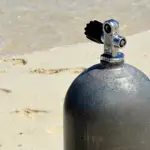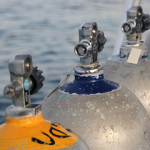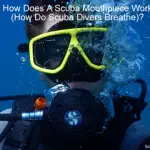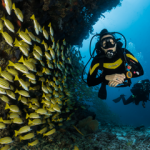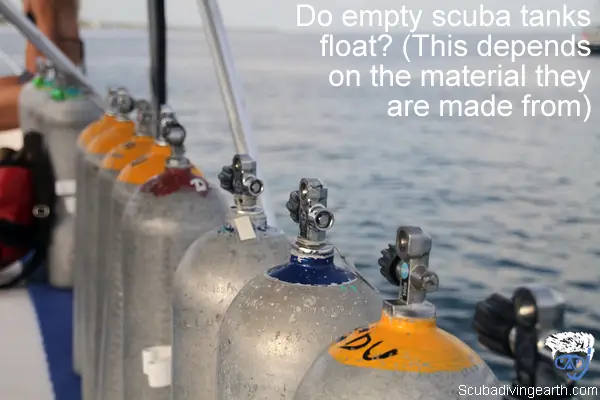
Do compressed air tanks float?
You may be wondering do empty scuba tanks float? The answer depends on what the scuba dive tank is made from. You may also be wondering what difference this makes when you’re scuba diving; this I will explain in this article.
Do empty scuba tanks float? Empty steel scuba tanks don’t float in water but become less negatively buoyant as the air is consumed. But aluminium dive tanks sink when full of air, but float when empty or on reserve air. This is important to understand for buoyancy control during your dive, as you become less buoyant as you consume more air.
The best way to do more diving where scuba cylinders are provided as part of the dive package, is to book yourself on a scuba diving liveaboard. You can check the latest and best deals on liveaboards using the following window:
Do empty scuba tanks float in more detail?
Whether or not an empty scuba tank floats is down to the material its made from. There are two main types of dive cylinder, which are steel and aluminium tanks.
One of these floats when empty, whereas the other doesn’t.
More Reading: What are scuba tanks made out of (Steel vs aluminium scuba tanks)
Do empty steel dive tanks float?
A dive cylinder made from steel is negatively buoyant when full. But a steel tank is also negatively buoyant when empty, which means it does not float when empty.
However, when a steel cylinder is empty, it is less negatively buoyant than a steel tank which is full with compressed air.
The amount of buoyancy of dive tanks is important for scuba divers when trying to maintain neutral buoyancy.
As you consume the air in your dive tank during the course of a dive, the tank reduces in negative buoyancy. That means at the end of the dive you’ll need slightly more weight than you will at the start of the dive to remain neutrally buoyant.
More Reading: How To Achieve Neutral Buoyancy Scuba Diving (Made Easy)
Do empty aluminium dive tanks float?
A dive cylinder made from aluminium is negatively buoyant when full. But an aluminium dive tank is positively buoyant when empty (see video below); i.e. an empty aluminium tank floats.
When I say empty, what I actually mean is when the tank has its reserve air remaining in the tank at the end of a dive.
The amount of reserve air recommended in the United States is 500psi, which in the UK is measured in BAR, and is 50 BAR. This means that an aluminium dive tank with 500 psi or 50 BAR will float in water.
This change from negative buoyancy to positive buoyancy during the dive will impact your overall neutral buoyancy.
This means that at the end of the dive if your dive tank is made from aluminium will increase your buoyancy.
Which means you’ll need more weight at the end of your dive to compensate for this added buoyancy. But of course you need to add this weight at the beginning of your dive before your descent.

Scuba tank buoyancy the difference between a full cylinder and an empty cylinder
Below is a great video showing the difference in buoyancy between an empty dive tank made from aluminium vs an aluminium dive tank that’s full of compressed air (or actually in the video the aluminium cylinder has its reserve air of 500psi or 50 BAR).
Keep in mind that all cylinders will undergo a change in their buoyancy characteristics during a dive as the gas that is contained inside of them is breathed. This means that you will always start the dive more negative, or sinking if you have no air in your BCD, then as the dive progresses you will become more positively buoyant as the tank becomes lighter because of the gas being breathed from it. The cylinder will be lighter at the end of the dive because it has less gas in it, and you will be more positively buoyant. If you performed the buoyancy check correctly, you will still not float. In this video I demonstrate how a full tank sinks while an empty one floats.
I hope you enjoyed this article about do empty scuba tanks float
I’d love to hear from you. Tell us about your adventures of diving and snorkeling, in the comments below. Please also share your photos. Either from your underwater cameras or videos from your waterproof Gopro’s!
If this article hasn’t answered all of your questions. If you have more questions either about snorkeling or scuba diving (or specifically about do empty scuba tanks float), please comment below with your questions.
There will also be many more articles about scuba diving (and snorkeling) for you to read and learn about these fabulous sports.
Have fun and be safe!

